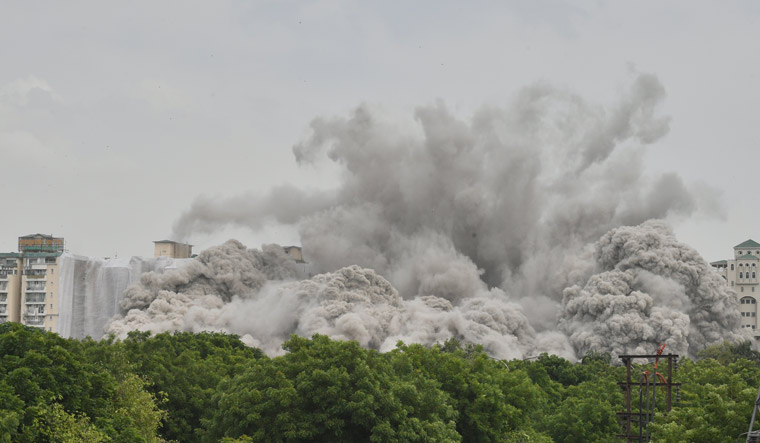Demolition experts would be chalking out a plan after discussion with resident associations in the vicinity of the razed down Noida twin towers regarding disposal of debris from the site. Experts said that it may take three months to clear the debris.
Mumbai-based Edifice Engineering partnered with South African firm Jet Demolitions for demolishing the 100-metre tall Noida twin towers on Sunday. The towers were razed down as per a Supreme Court order in August last year after the Court found illegalities in their construction. The two had previously demolished four residential complexes in Maradu municipal area of Kochi, Kerala in a similar fashion.
The illegal twin towers in Noida's Sector 93A were grounded by 'waterfall implosion' technique in a matter of 12 seconds, Joe Brinkman of South African firm Jet Demolitions said. The Apex (32 storeys) and Ceyane (29 storeys) towers of Supertech had a height of 103 metres each, according to officials.
Jet Demolitions holds a distinguished position globally for demolition works. In November 2019, the firm grounded the 108-metre-tall Bank of Lisbon building in Johannesburg within a few seconds in an eye-popping event and ensured that a structure barely seven metres next to it was safe too.
Joe Brinkman of Jet Demolitions told reporters that the whole process of demolishing the Noida twin towers took 12 seconds. He said the team's first priority was to ensure that there were no injuries to people during the implosion and no structural damage caused to any of the buildings around. He added that very few buildings taller than 100 metres have been demolished in a controlled manner across the world.
Edifice Engineering partner Utkarsh Mehta described Brinkman as the "mastermind" of the successful demolition. He said around 35,000 cubic metres or approximately 80,000 tonnes of debris was left after the demolition.
Around 50,000 tonnes of it has been absorbed in the basements of the now-demolished towers while the remaining would be disposed of in 90 days, he said.
“We will have to coordinate with the Emerald Court and ATS Village societies for the disposal since the debris would have to be first processed at the site only and then it would be taken to construction and demolition waste processing centres,” Mehta said.
Coordination would be needed for fixing the timing for work at the site to cause the least disturbance to residents, said Mehta. Jigar Chheda, another Edifice partner, said they took six months to plan the clean execution of the demolition and the whole exercise was a very challenging process.
Days and nights went into the preparation for this day. Over 9,000 holes were drilled for explosives in the two buildings; they had to be most accurate and all this was challenging, Chheda told PTI.
Getting permission from all authorities concerned, coordinating with multiple agencies, and convincing residents of safety were key effort areas, he said. Mayur Mehta, project manager for Edifice, said 9,642 holes were drilled and 3,700 kilos of explosives were used for the demolition.
The types of explosives used were solar coal with 6 gm, 10 gm, 20 gm, and 80 gm mass. Electric detonators, shock tubes and emulsions were also used. The tubes were placed in a way that some had a 0.5-millisecond explosion capacity, while others had a 7,000-millisecond capacity, he added.
Edifice officials said nine metres of the boundary wall of ATS Village comprising some 900 bricks were damaged. Several window panes in Emerald Court, as well as ATS Village, were cracked and they had started the process to replace them with new ones shortly after inspection at the site Sunday evening.
(With inputs from PTI)




